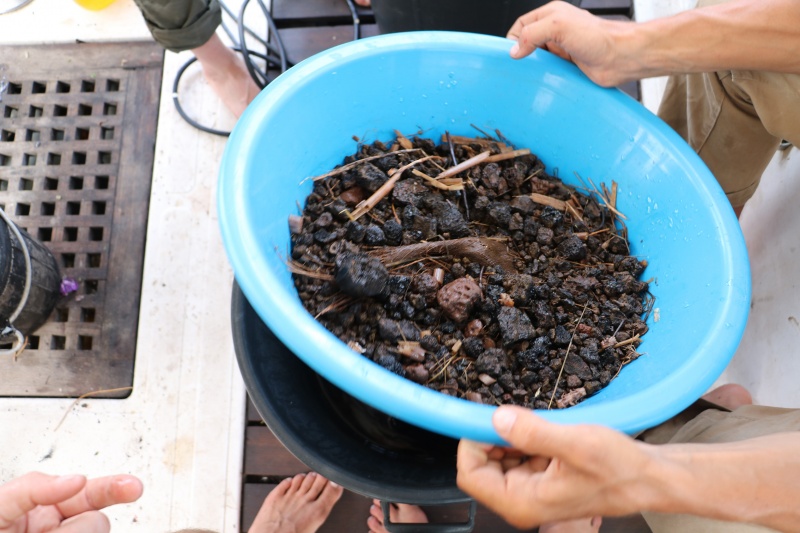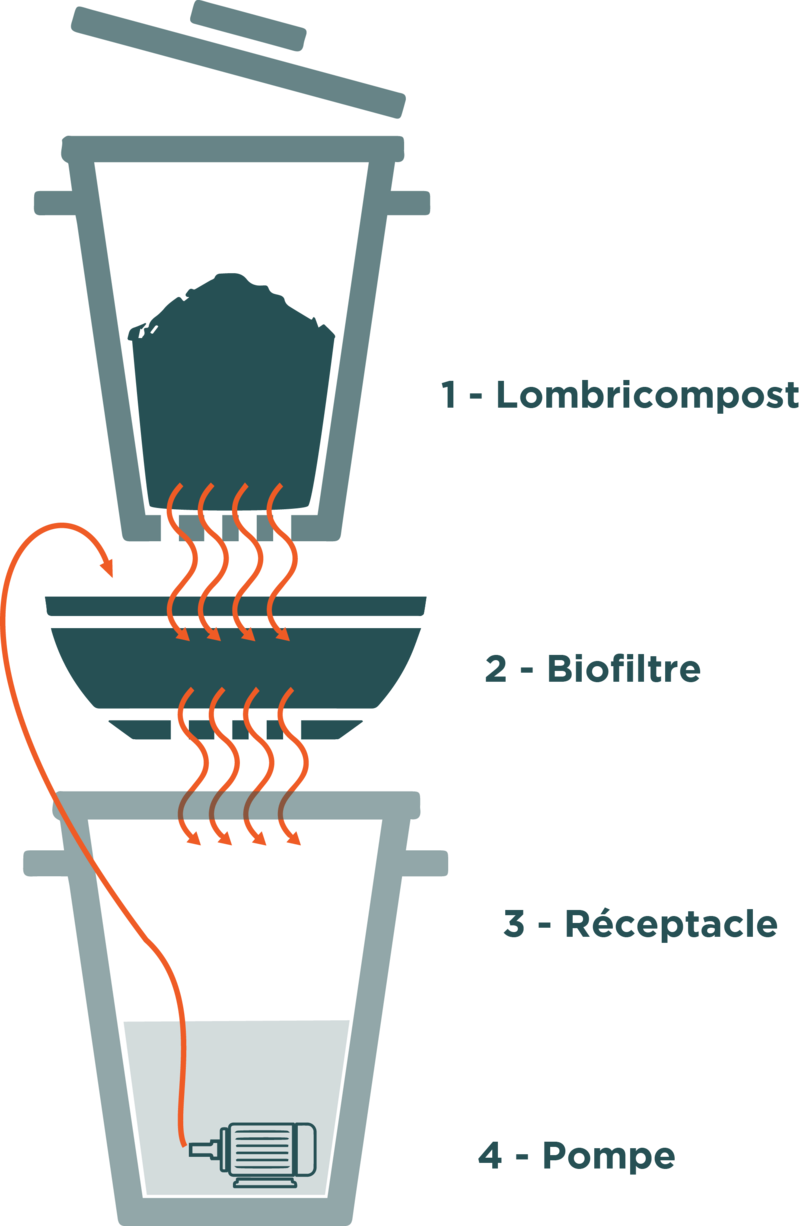(Page créée avec « - Good aeration (add layer of straw (1cm approx) after adding food waste) ») |
(Page créée avec « * The leachate (brown liquid) can be easily retrieved by emptying the contents of the reservoir. Using a funnel, pour the leachate into bottles but allow it to aerate as i... ») |
||
| Ligne 133 : | Ligne 133 : | ||
- Good aeration (add layer of straw (1cm approx) after adding food waste) | - Good aeration (add layer of straw (1cm approx) after adding food waste) | ||
| − | * | + | * The leachate (brown liquid) can be easily retrieved by emptying the contents of the reservoir. Using a funnel, pour the leachate into bottles but allow it to aerate as it is a living environment. Without air, organic matter will ferment and therefore gives off an offensive smell which may be very unpleasant for you. |
* Première récolte après 15 jours de fonctionnement du système. Application sur les plantes : 10ml pour 10 litres, augmentez suivant observation (si le milieu est vert pâle augmenter les doses). | * Première récolte après 15 jours de fonctionnement du système. Application sur les plantes : 10ml pour 10 litres, augmentez suivant observation (si le milieu est vert pâle augmenter les doses). | ||
Version du 24 juillet 2018 à 15:42
Description
How to make organic fertiliser that can be directly absorbed by plants by combining a biofilter with worm compost.
Introduction
"Worm Composting"
Worm composting works by breaking down organic waste using earthworms (notably Eisenia Fetida) which mimics the process performed by living organisms in the surface layer of the soil. Food waste (vegetable peelings, scraps of food, even animal carcasses, faeces etc.) is a source of nourishment which is eaten and digested by micro-organisms (bacteria and fungi) and earthworms in the worm compost.This process of digestion promotes mineralisation of waste products, converting them into simple elements (azote, potassium, phosphorus, magnesium, calcium, iron , trace elements etc.) which can then be absorbed by plants, giving them essential nutrients for their growth and development
The end-products of this process are leachate (or ‘brown liquid’ from compost) and ‘worm tea’ from humus.
Leachate (brown liquid) is rich in nutrients, beneficial micro-organisms and organic molecules yet to be broken down and is made up of liquid earthworm faeces, moisture from compost and fresh plant matter which has fallen from above.
Humus (a dark, lumpy substance that feels moist to touch) contains essential minerals for plants, humic acid (the molecule which stimulates their metabolism and root growth) and decomposers in the form of beneficial micro-organisms. It effectively acts as a larder as it stores nutrients to which plants have a progressive and continuous supply.
The Biofilter
The way this works is that decomposers effectively finish off the process of “digesting” chemical compounds which are then readily and directly accessible to the plant. In healthy soil, this is a continuous process.
The liquid which comes from out of the biofilter contains beneficial micro-organisms and elements which can be easily absorbed by plants. The benefits of this process taking place in a biofilter is that it prevents the plant roots from rotting and resulting in decay or deficiencies. An aerobic process takes place in the biofilter i.e. in the presence of oxygen.
The biofilter uses an active flow of liquid (water + organic matter) which acts as an ‘oxygenating fountain’ by cascading onto beds which are made of microporous and aerated material such as volcanic rock, pumice stone or expanded clay balls and beds made of aerated materials high in cellulose such as straw, dried grass, dried reeds etc. suitable for the growth of fungi.
Why combine worm compost with and a biofilter?
The Leachate (or brown liquid) that is collected after composting is a substance that has not entirely been broken down.Adding a biofilter to the worm compost allows completion of the process which produces the different nutrients needed by the plant . You then end up with a “fertiliser” which can be used even on an inert substrate (as with soil-less cultivation or hydroponics) which in turn brings beneficial micro-organisms into the system.
Humus can be harvested either by hand-sorting or waiting until the earthworms have migrated. It then can be used to enrich soil or potting substrates. This system works by the earthworms building their colony in the upper section (approximately in the first 15 centimetres) with the humus that has been produced remaining in the lower section and the leachate draining into the biofilter which then becomes enriched with nutrients as it passes through the humus. This type of worm composter is mostly used for collecting leachate.
Uses:
There are varying scales of worm composting: from large scale operations for spreading on crops to making it on much smaller, domestic scale e.g. for making fertiliser for personal use to grow plants either with or without soil. The real benefits can be seen both in isolated areas where there is farming activity or even in urban areas where crops are grown out of the soil (e.g. on rooftops) a virtuous feeding cycle can be established by combining the processes of recycling organic waste with producing fertiliser for plants.
In this tutorial, you will learn ways in which can make your own worm compost (approximately 50L for each of the biofilter and worm composting systems).
There are, of course, alternative ways it can be made using different ratios and other materials, but this one is thought to be the one which can be achieved successfully by most people and can be adapted to suit local conditions.
Matériaux
2 x 60L containers, e.g. plastic rubbish bins (preferably made of solid, durable inert plastic) 1 x lid 1 x 15L (approx.) bowl of an equal diameter to the container (preferably made of solid durable inert plastic) Water pump/airlift pump for pond or aquarium min. 300 L/hour to a height of 1m 50cm hose pipe (with a diameter which will fit the pump output) Expanded clay ball or porous volcanic rock (microporous materials are good for making a solid habitat for mirco-organisms): approximately 5L for the biofilter and 5L for the worm composter (bedding material for drainage) Straw/dried vegetation (habitat made of materials high in cellulose for micro-organisms), approximately 5L for the biofilter and 5 L for the worm composter Water: approximately 40L Fungi (Trichoderma or Strepomyces) (GHE - BM or Subculture) or rotting organic matter, A good selection of earthworms (min. 50)
Outils
- Electric drill
Étape 1 - Steps involved in making the System
1) Worm Composter
2)' Biofilter
3) Biofilter reservoir (receptacle and pump)
Étape 2 - Worm Composter
1) Drill 7 or 8 small holes in the bottom of one of the 60L containers
Place the container on top of the bowl (biofilter)
3) Fill the worm compost with the following:
1st layer: porous rocks (base layer- made of bedding material suitable for drainage) and straw (this first layer is for earthworm reproduction).
2nd layer: organic waste and 20 to 40 earthworms
3rd layer: Straw (2nd lot of bedding material for earthworm reproduction)
4) Cover the worm composter with a lid.
Étape 3 - The Biofilter
1) Drill a hole the same diameter as your hose in the centre of your bowl.
2) Drill smaller holes in the bottom of the bowl.This allows the liquid to flow from the bowl to the container.
3) Place the bowl over the container.
4) Feed the pipe through the hole in the bowl and check that the pump is still submerged under the water at the bottom of the container.
5) Fill the bowl with the straw, porous rocks and fungi. (You can buy these from GHE - General Hydroponics Europe, 10g per 10L or approximately 2 teaspoons).
Note: You can also use rotting organic matter.Decomposers (micro-organisms) can be found under rotting branches and can be recognised by a film of whitish mould.
6) Putting a piece of open-weave canvas on the end of the pipe allows the water to circulate in the pipe without having to bypass the rock or the straw.
Étape 4 - The Biofilter Reservoir
1) Connect the pump to the hose.
2) Place it right at the back of the second 60L container.
3) Pour 15 to 20L of water into the container.
Caution: In order to retain the cascading effect from the biofilter, the liquid in the container should not exceed the 40L level. To avoid damage to the pump through turning it on without water, do not fill under the 10L level.
Étape 5 - Directions for Use
- It is best to feed the worm compost in phases: a 10L bucket with lid can be used to collect the waste (approximately 1 week’s worth) before adding it into the system.
Then cover with a bed of 1cm (approx.) of straw. This is used as a shelter for the worms and is an area where they can reproduce before the next application.
- In order that waste breaks down correctly, the following conditions are required at the same time:
- Temperature and humidity should be sufficiently high: worm compost should stay moist - even pour a small amount of water over it if necessary. Don’t hesitate to throw in the remains from your teapot or coffee-maker (worms love caffeine!). Water (without added salt) from boiled rice can also be a treat for earthworms.
- PH value must be more or less neutral: The PH value of all the different foods added must be evened out (e.g. avoid only pasta)
- Good aeration (add layer of straw (1cm approx) after adding food waste)
- The leachate (brown liquid) can be easily retrieved by emptying the contents of the reservoir. Using a funnel, pour the leachate into bottles but allow it to aerate as it is a living environment. Without air, organic matter will ferment and therefore gives off an offensive smell which may be very unpleasant for you.
- Première récolte après 15 jours de fonctionnement du système. Application sur les plantes : 10ml pour 10 litres, augmentez suivant observation (si le milieu est vert pâle augmenter les doses).
Notes et références
Ce biofiltre a été réalisé avec l'aide deThomas Blanguille expert en hydroponie.
Visionner la vidéo Arte Future - Cap sur l'innovation en attendant le tutoriel.
N'hésitez pas à commenter, partager, et agrémenter le tutoriel d'informations utiles à son amélioration.
L’équipe du Low-Tech Lab vous invite également à consulter sa Biblilowtech.
Yes


 Français
Français English
English Deutsch
Deutsch Español
Español Italiano
Italiano Português
Português